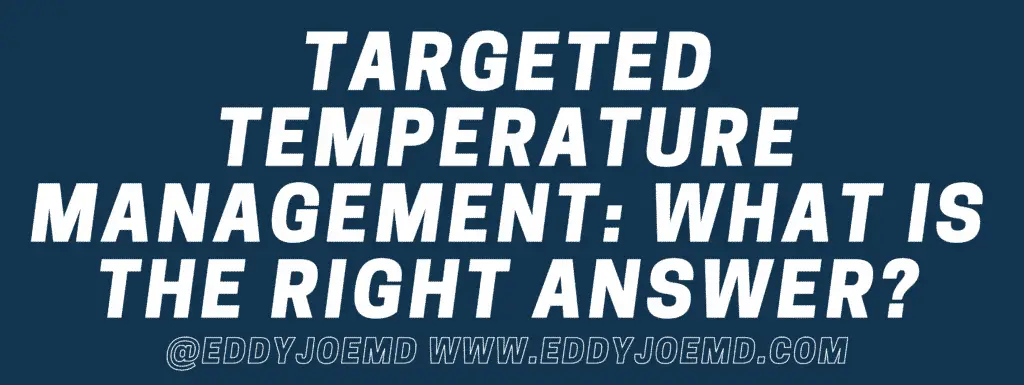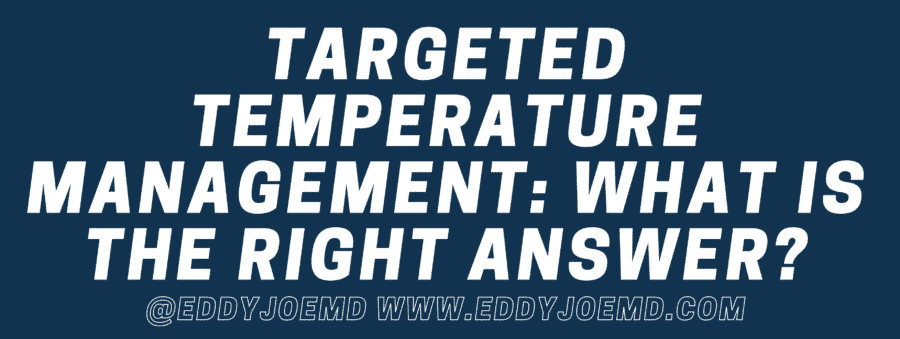Way back when I was just a baby intern, I remember placing these large IJ cannulas in the patients who suffered cardiac arrests to proceed with hypothermia. Later in my training, in December of 2013, the NEJM published the Targeted Temperature Management (TTM trial) looking at 33°C versus 36°C after Cardiac Arrest. The paradigm began to shift towards normothermia although there are many individuals who had, and still have, a challenging time changing their practice. Since then, other studies have been published such as the HYPERION trial which I already went to town on in criticizing it. For some quick background on that study, they looked at 33°C vs. 37°C. If you’re interested in reading/hearing my take on the article, CLICK HERE. ADDENDUM: SEE CITATIONS BELOW FOR UPDATED ARTICLES including the one shared on 3/24/22.
In order to attempt to settle this debate once and for all, the TTM2 trial was published on June 17, 2021 in NEJM titled “Hypothermia versus Normothermia after Out-of-Hospital Cardiac Arrest“. Hopefully this will settle the debate. The whole thought process behind cooling patients who suffered a cardiac arrest is to improve their neurological outcomes versus normothermia.
These past trials have looked at cooling patients to 33°C or normothermia which they described as either 36°C or 37°C depending on the trail. The key risk factor that seems to correlate most with a poor neurologic outcome appeared to be fever. There was a lot of fever going on in the normothermia group of the HYPERION trial as reflected in Figure 2. To disclose my bias right off the bat, I am not a fan of using therapeutic hypothermia. This is due to the environment where I was trained as well as the data I have read and interpreted myself.
The reason why this question needs to be answered boils down to resources. Let’s be quite frank that a patient who undergoes the typical 33 degree hypothermia protocols requires devices to cool the patient down such as ice packs, cooling blankets, and intravascular devices. In addition, one needs to check serial labs to make sure that nothing breaks, i.e. organs or blood, in the process. Then, there is a specified amount of time that a patient needs to be cooled, in theory. The rewarming process also needs to be carefully monitored as electrolyte shifts can be noted.
In the TTM-2 trial, they cooled the patients to 33°C for 28 hours after randomization. They rewarmed the patients in hourly increments of 1/3 of a degree Celsius. For those patients who were not randomized to the hypothermia group, they were shooting for a temperature of 37.5°C. For the sake of being Americans and using Fahrenheit rather than Celsius, keep in mind that 38°C is 100.4°F. Don’t be ashamed, I have to look that up myself periodically. Patients were provided with 96 hours to wake up. To keep the patients at 37.5°C, cooling blankets and intravascular devices were also utilized in this study if they reached a body temperature of 37.8°C or higher. This provides us with some insight as to how we can avoid fever in our patients who we will not be cooling moving forward.
Let’s be clear, therapeutic hypothermia is not a benign procedure for its theoretical benefits compared to normothermia. 6% of the patients enrolled in the hypothermia group had to be rewarmed early because of cardiovascular instability and arrhythmias. The number needed to treat to cause an arrhythmia that results hemodynamic compromise is 12.5. There was no difference in bleeding, pneumonia, nor sepsis in the two groups. The authors stated that the reason for hemodynamic compromise could have been secondary to “electrolyte disturbances, fluid status, and a temperature effect on the cardiac myocytes”.
Compared to the TTM trial which enrolled 950 patients and the HYPERION trial which enrolled 584, the TTM2 trial enrolled 1850 patients in their trial. The researchers obviously could not blind the physicians in the study because all it takes is a physical exam to determine whether a patient is at 33°C or a temperature higher than that. When looking at the baseline characteristics of the patients, it is interesting to see that the majority of the arrests were at the patient’s own place of residence. Also, 25% of the rhythms were non-shockable rhythms. Something to consider was that the median time from cardiac arrest to obtaining return of spontaneous circulation was 25 minutes. This can provide some insight into how long we should run ACLS codes in certain patients.
Cardiac arrest with a shockable or non-shockable rhythm? My take on this is simple, perhaps too simple, who the hell cares? A cardiac arrest patient should be treated the same either way. Who knows if it was a shockable rhythm at first that then degraded to a not-shockable rhythm? Turns out that the authors here felt the same way I do and they enrolled 72-75% of patients with a shockable rhythm and the rest were non-shockable rhythms. In my practice, I would provide no weight to whether it was a shockable versus non-shockable rhythm. Either way, my job is to sort out the etiology of the arrest, fix that etiology if I can, keep them stable, and allow for optimal neurologic recovery.
The bottom line of this study showed that using hypothermia was no better than normothermia of 37.5°C and actively avoiding fever by using therapies such as cooling blankets. There was no difference in death by any cause at 6 months, no difference in the main secondary outcomes of modified Rankin scores nor functional outcome at 6 months. In my practice, I have been using normothermia for several years and with these data I will continue to do so. We have aggressively been treating fever when it arises and will continue to do so. A definite hat tip to the authors. Please read the article for yourself and do not trust me. After all, this is not a recommendation nor medical advice. Normothermia for the win!
The Recommendations from the European Resuscitation Council (ERC) and the European Society of Intensive Care Medicine (ESICM): Updated 2/10/22
Sandroni C, Nolan JP, Andersen LW, Böttiger BW, Cariou A, Cronberg T, Friberg H, Genbrugge C, Lilja G, Morley PT, Nikolaou N, Olasveengen TM, Skrifvars MB, Taccone FS, Soar J. ERC-ESICM guidelines on temperature control after cardiac arrest in adults. Intensive Care Med. 2022 Jan 28. doi: 10.1007/s00134-022-06620-5. Epub ahead of print. PMID: 35089409.
Link to Article
Link to FULL FREE PDF
If you want to learn whether to place an IV or IO access during a code, CLICK HERE!
Citations Regarding Normothermia
Nielsen N, Wetterslev J, Cronberg T, Erlinge D, Gasche Y, Hassager C, Horn J, Hovdenes J, Kjaergaard J, Kuiper M, Pellis T, Stammet P, Wanscher M, Wise MP, Åneman A, Al-Subaie N, Boesgaard S, Bro-Jeppesen J, Brunetti I, Bugge JF, Hingston CD, Juffermans NP, Koopmans M, Køber L, Langørgen J, Lilja G, Møller JE, Rundgren M, Rylander C, Smid O, Werer C, Winkel P, Friberg H; TTM Trial Investigators. Targeted temperature management at 33°C versus 36°C after cardiac arrest. N Engl J Med. 2013 Dec 5;369(23):2197-206. doi: 10.1056/NEJMoa1310519. Epub 2013 Nov 17. PMID: 24237006.
Link to Article
Link to FULL FREE PDF
Lascarrou JB, Merdji H, Le Gouge A, Colin G, Grillet G, Girardie P, Coupez E, Dequin PF, Cariou A, Boulain T, Brule N, Frat JP, Asfar P, Pichon N, Landais M, Plantefeve G, Quenot JP, Chakarian JC, Sirodot M, Legriel S, Letheulle J, Thevenin D, Desachy A, Delahaye A, Botoc V, Vimeux S, Martino F, Giraudeau B, Reignier J; CRICS-TRIGGERSEP Group. Targeted Temperature Management for Cardiac Arrest with Nonshockable Rhythm. N Engl J Med. 2019 Dec 12;381(24):2327-2337. doi: 10.1056/NEJMoa1906661. Epub 2019 Oct 2. PMID: 31577396.
Link to Article
Link to FULL FREE PDF
Dankiewicz J, Cronberg T, Lilja G, Jakobsen JC, Levin H, Ullén S, Rylander C, Wise MP, Oddo M, Cariou A, Bělohlávek J, Hovdenes J, Saxena M, Kirkegaard H, Young PJ, Pelosi P, Storm C, Taccone FS, Joannidis M, Callaway C, Eastwood GM, Morgan MPG, Nordberg P, Erlinge D, Nichol AD, Chew MS, Hollenberg J, Thomas M, Bewley J, Sweet K, Grejs AM, Christensen S, Haenggi M, Levis A, Lundin A,
Düring J, Schmidbauer S, Keeble TR, Karamasis GV, Schrag C, Faessler E, Smid O, Otáhal M, Maggiorini M, Wendel Garcia PD, Jaubert P, Cole JM, Solar M, Borgquist O, Leithner C, Abed-Maillard S, Navarra L, Annborn M, Undén J, Brunetti I, Awad A, McGuigan P, Bjørkholt Olsen R, Cassina T, Vignon P, Langeland H, Lange T, Friberg H, Nielsen N; TTM2 Trial Investigators. Hypothermia versus Normothermia after Out-of-Hospital Cardiac Arrest. N Engl J Med. 2021 Jun 17;384(24):2283-2294. doi: 10.1056/NEJMoa2100591. PMID: 34133859.
Link to Article (NOT FREE)
ARTICLE SHARED ON INSTAGRAM ON 09/13/21
Granfeldt A, Holmberg MJ, Nolan JP, Soar J, Andersen LW; International Liaison Committee on Resuscitation (ILCOR) Advanced Life Support Task Force. Targeted temperature management in adult cardiac arrest: Systematic review and meta-analysis. Resuscitation. 2021 Aug 30;167:160-172. doi: 10.1016/j.resuscitation.2021.08.040. Epub ahead of print. PMID: 34474143.
Link to Article
Link to FULL FREE PDF
Sandroni C, Nolan JP, Andersen LW, Böttiger BW, Cariou A, Cronberg T, Friberg H, Genbrugge C, Lilja G, Morley PT, Nikolaou N, Olasveengen TM, Skrifvars MB, Taccone FS, Soar J. ERC-ESICM guidelines on temperature control after cardiac arrest in adults. Intensive Care Med. 2022 Jan 28. doi: 10.1007/s00134-022-06620-5. Epub ahead of print. PMID: 35089409.
Link to Article
Link to FULL FREE PDF
ARTICLE SHARED ON SOCIAL MEDIA ON 3/24/22
Aneman A, Frost S, Parr M, Skrifvars MB. Target temperature management following cardiac arrest: a systematic review and Bayesian meta-analysis. Crit Care. 2022 Mar 12;26(1):58. doi: 10.1186/s13054-022-03935-z. PMID: 35279209; PMCID: PMC8917746.
Link to Article
Link to FULL FREE PDF
How to support my work
My efforts are at no cost to you and I would like to keep it that way. You have to look at ads on this website, listen to them on my podcast and YouTube content. Thanks for bearing with me. But if you want to help out a little more, you could also support my work by clicking on my Amazon Affiliate links prior to ordering things off of Amazon.
For example, if you want to learn more about Mechanical Ventilation, I recommend starting off with The Ventilator Book by Will Owens. If you click on that link, a window for Amazon will open up and I will earn between a 1-3% commission at no expense to you. The fun thing is that if you order anything else on Amazon, I will earn that amount off of your shopping cart even if you do not purchase the book. Pretty cool right? In 2020 Amazon Affiliates helped me pay for the hosting of my website, LLC fees, and Netflix.
Although great care has been taken to ensure that the information in this post is accurate, eddyjoe, LLC shall not be held responsible or in any way liable for the continued accuracy of the information, or for any errors, omissions or inaccuracies, or for any consequences arising therefrom.

